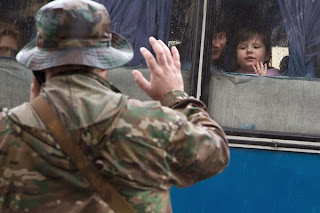Latest from OSCE Special Monitoring Mission (SMM) to Ukraine based on information received as of 18:00 (Kyiv time), 23 September 2014
KYIV 24 September 2014
The SMM observed the situation in Donbas, with a particular focus on implementation of the provisions of the Memorandum signed on 19 September in Minsk. It also continued to monitor the situation of IDPs.
The situation in Kharkiv was calm.
Nikolay Kozitsyn, a commander of Don Cossacks, de facto controlling south-western areas of the Luhansk region, warned the SMM that he would not allow any patrols of OSCE monitors without prior arrangement.
The SMM heard sounds of shelling from 11:43 to 12:15 emanating from the vicinity of Shchastya (23km north of Luhansk) power plant, controlled by Ukrainian forces, notably a volunteer Aidar battalion. The shelling was also corroborated by local residents, but rejected by the commander of Aidar’s unit, stationed in the power plant. The latter also said that the power plant, providing energy for the whole region, was continuously attacked by irregular armed groups.
On 22 September, at 20:10, the SMM heard around 17 explosions in rapid succession in Tekstylnyk: the south-west district of Donetsk. The SMM saw also flashes in the clouds, similar to lightning. At 20:25 the SMM heard another series of 26 explosions.
The SMM observed a simultaneous release of hostages and detainees between the Ukrainian Army and the ‘LPR’ in the area of Krasnyi Luch village (26km west of Luhansk). One ‘LPR’ detainee and six Ukrainian soldiers were released.
The ‘military police’ of ‘Donetsk People’s Republic’ (‘DPR’) told the SMM that three unmarked graves allegedly containing multiple bodies had been found; two of them were located in a coal mine Komunar near the village Nyzhnia Krynka (35km north-east of Donetsk) and one inside the village. The SMM proceeded to the scene and saw in the coal mine two areas located fifty metres apart, each containing two human bodies. All four corpses were in the process of decomposition. The SMM also saw eight 9mm Makarov pistol cartridges approximately five meters away from the bodies. Near the road on the edge of the village, the SMM observed a pile of earth resembling a grave which had a stick with a plaque, written in Russian and containing the names (or in one case – initials) of five individuals. The plaque indicated that the individuals died on 27.08.2014. On top of the plaque there was another inscription saying: ‘Died for Putin’s lies’. Neither in the coal mine nor in the village did the SMM see any forensic experts. COMMENT: The SMM cannot provide a forensic assessment of the sites.
Also in Nyzhnia Krynka the SMM observed a destroyed bridge over the water reservoir, connecting the locality with Donetsk. According to local residents the bridge was blown up by Ukrainian soldiers leaving the area around 18 September.
Acting head of Kramatorsk’s (97km north of Donetsk) administration informed the SMM there were approximately 1,700 registered IDPs in town, but their real number was much higher since many had not registered. She mentioned that the number of IDPs was growing and that currently IDPs were mainly coming from Horlivka (44km north of Donetsk). She also claimed that the city was not receiving any help to tackle the IDP issues. A staff member of the local registration centre estimated that the total number of IDPs in Kramatorsk is about 5,000, and that 2,000 of them are school children.
In Mariupol, on 22 September, the SMM heard sounds consistent with anti-aircraft and small arms fire from 20:10 to 20:45, emanating from the west. On the following day the ATO HQ representative confirmed this incident, and claimed that the Ukrainian army had been targeting unmanned aerial vehicles flying in the area.
The SMM visited a temporary checkpoint of the Ukrainian army near Talakivka (20km north-west of Mariupol), which had been shelled on 22 September from the north-east direction, and observed twelve shell craters in the vicinity of the checkpoint; at least eight houses and two gas pipelines were seriously damaged. The SMM observed checkpoint personnel preparing to detonate an unexploded mortar shell lodged in the road about 30 meters away from the area. One local resident, who lived across the street from one of the damaged pipelines, confirmed the attack.
The Co-ordinator of the Women’s Sotnia (literally: a centuria, a military unit of around 100 soldiers) of the National Defence Head Quarter in Dnipropetrovsk informed the SMM that female volunteers rendered assistance to IDPs, collected food, clothes and medicine for wounded soldiers, and organised fundraising to support Ukrainian troops and soldiers’ families. Some women from the sotnia served in conflict zones as volunteers in medical and logistical units; inter alia they took dead or wounded soldiers from the battle field. Between 10 and 15 women were fighting in different battalions.
The situation in Kherson, Odessa, and Chernivtsi was calm.
Representatives of Caritas, a charitable organization of the Catholic Church, told the SMM in Ivano-Frankivsk that there was enough accommodation suitable for winter in the region, however many IDPs had difficulties paying the rent and utilities – currently Caritas pay the rent for the first two months of their stay. Representatives of Caritas also highlighted that Ukrainian soldiers, injured in the ATO, often received less assistance than IDPs.
The situation in Lviv and Kyiv was calm.
http://www.osce.org/ukraine-smm/124216


